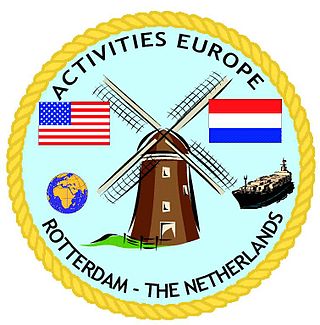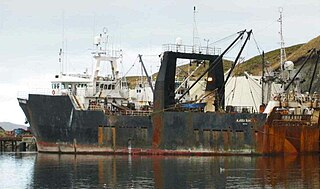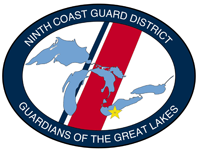
The United States Coast Guard (USCG) is the maritime security, search and rescue, and law enforcement service branch of the United States Armed Forces and one of the country's eight uniformed services. The service is a maritime, military, multi-mission service unique among the United States military branches for having a maritime law enforcement mission with jurisdiction in both domestic and international waters and a federal regulatory agency mission as part of its duties. It is the largest and most powerful coast guard in the world, rivaling the capabilities and size of most navies.

A coast guard or coastguard is a maritime security organization of a particular country. The term embraces wide range of responsibilities in different countries, from being a heavily armed military force with customs and security duties to being a volunteer organization tasked with search and rescue without law enforcement authority. In most countries, a typical coast guard's functions are distinct from those of the navy and the transit police, while in certain countries they have similarities to both.

The Canadian Coast Guard is the coast guard of Canada. Formed in 1962, the coast guard is tasked with marine search and rescue (SAR), communication, navigation, and transportation issues in Canadian waters, such as navigation aids and icebreaking, marine pollution response, and support for other Canadian government initiatives. The coast guard operates 119 vessels of varying sizes and 23 helicopters, along with a variety of smaller craft. The CCG is headquartered in Ottawa, Ontario, and is a special operating agency within Fisheries and Oceans Canada.

The United States Coast Guard Auxiliary is the civilian uniformed volunteer component of the United States Coast Guard. Congress established the unit on 23 June 1939, as the United States Coast Guard Reserve. On 19 February 1941, the organization was re-designated as the United States Coast Guard Auxiliary. The Auxiliary exists to support all USCG missions on the water or in the air, except for roles that require "direct" law enforcement or military engagement. As of 2022, there were approximately 21,000 members of the U.S. Coast Guard Auxiliary.

The International Ship and Port Facility Security (ISPS) Code is an amendment to the Safety of Life at Sea (SOLAS) Convention (1974/1988) on Maritime security including minimum security arrangements for ships, ports and government agencies. Having come into force in 2004, it prescribes responsibilities to governments, shipping companies, shipboard personnel, and port/facility personnel to "detect security threats and take preventive measures against security incidents affecting ships or port facilities used in international trade."

USCGC Alder (WLB-216) is the final Juniper-class, 225-foot (69 m) seagoing buoy tender of the United States Coast Guard.
The Maritime Transportation Security Act of 2002 (MTSA) is an Act of Congress enacted by the 107th United States Congress to address port and waterway security. It was signed into law by President George W. Bush on November 25, 2002.
The United States Coast Guard is the coastal defense, search and rescue, and maritime law enforcement branch of the United States Armed Forces and is one of the country's eight uniformed services. It carries out three basic roles, which are further subdivided into eleven statutory missions. The three roles are:

The National Cargo Bureau (NCB) a not-for-profit marine surveying organization charged with assisting the U.S. Coast Guard with carrying out the provisions of the International Convention for the Safety of Life at Sea. The NCB was formed by a group of marine underwriters and the Coast Guard for the purpose of reducing losses of grain ships. Any ship loading grain in the US sailing for a foreign port must have a certificate issued by the NCB in order to sail( See U.S. Coast Guard Navigation and Vessel Inspection Circular No. 5-94 - NVIC 05-94 ). The NCB acts with and enforces the regulations of the Coast Guard in this area. Grain ships have unique stability issues and are prone to capsize if loaded improperly. Headquartered in New York City, the NCB has offices throughout United States.
Sector Commander is the position title of the commanding officer of a United States Coast Guard Sector, usually of the rank of Captain (O-6). The Sector Commander's second-in-command is the Deputy Sector Commander. Also reporting directly to the Sector Commander are the Command Master Chief (CMC), the Senior Reserve Officer, and the Sector's Auxiliary Coordinator.
A Sector is a shore-based operational unit of the United States Coast Guard. Each Sector is responsible for the execution of all Coast Guard missions within its Area of Responsibility (AOR), with operational support from Coast Guard Cutters and Air Stations. Subordinate commands within a Sector typically include Stations and Aids-to-Navigation (ATON) Teams. Some Sector commands also have subordinate units such as Sector Field Offices and Marine Safety Units that are responsible for mission execution in parts of the Sector's AOR. There are 37 sectors within the Coast Guard.

Vessel Monitoring Systems (VMS) is a general term to describe systems that are used in commercial fishing to allow environmental and fisheries regulatory organizations to track and monitor the activities of fishing vessels. They are a key part of monitoring control and surveillance (MCS) programs at national and international levels. VMS may be used to monitor vessels in the territorial waters of a country or a subdivision of a country, or in the Exclusive Economic Zones (EEZ) that extend 200 nautical miles (370.4 km) from the coasts of many countries. VMS systems are used to improve the management and sustainability of the marine environment, through ensuring proper fishing practices and the prevention of illegal fishing, and thus protect and enhance the livelihoods of fishermen.

United States Coast Guard activities Europe (ACTEUR) is a Coast Guard Marine Safety unit located in Schinnen, The Netherlands.

Cruise ships carrying several thousand passengers and crew have been compared to “floating cities,” and the volume of wastes that they produce is comparably large, consisting of sewage; wastewater from sinks, showers, and galleys (graywater); hazardous wastes; solid waste; oily bilge water; ballast water; and air pollution. The waste streams generated by cruise ships are governed by a number of international protocols and U.S. domestic laws, regulations, and standards, but there is no single law or rule. Some cruise ship waste streams appear to be well regulated, such as solid wastes and bilge water. But there is overlap of some areas, and there are gaps in others.

In the United States, several federal agencies and laws have some jurisdiction over pollution from ships in U.S. waters. States and local government agencies also have responsibilities for ship-related pollution in some situations.

FV Alaska Ranger was a fishing factory ship owned and operated by the Fishing Company of Alaska of Seattle, Washington. The ship was constructed in 1973 for use as an oil field service vessel. The ship sank 23 March 2008, after reporting progressive flooding only hours earlier. Of the 47 on board, 42 were rescued. Of the five fatalities, four were recovered dead, and one was never found. The Coast Guard was initially misinformed about the number of persons on board the vessel, and secured the search with one crew member still unaccounted for. After realizing there was still one person missing, the Coast Guard reinstated the search, but did not find the crew member.
Ship registration is the process by which a ship is documented and given the nationality of the country to which the ship has been documented. The nationality allows a ship to travel internationally as it is proof of ownership of the vessel.

Marine Science Technician (MST) is an enlisted rate in the United States Coast Guard. They are specialists in enforcing Federal Maritime Laws for Marine Safety, Marine Security, and Environmental Protection.

USCGC Walnut (WLB-205) is the fifth cutter in the Juniper-class 225 ft (69 m) of seagoing buoy tenders and is the second ship to bear the name. She is under the operational control of the Commander of the Fourteenth Coast Guard District and is home-ported on Sand Island in Honolulu, Hawaii. Her primary area of responsibility is the coastal waters and high seas around the Hawaiian Islands and American Samoa. Walnut conducts heavy lift aids-to-navigation operations, and law enforcement, homeland security, environmental pollution response, and search and rescue as directed.

District 9 is a United States Coast Guard district located at the Anthony J. Celebrezze Federal Building in Cleveland, Ohio. District 9 is responsible for all Coast Guard operations on the five Great Lakes, the Saint Lawrence Seaway, and surrounding states accumulating 6,700 miles of shoreline and 1,500 miles of international shoreline with Canada.













